| This article has an unclear citation style. The references used may be made clearer with a different or consistent style of citation and footnoting. (May 2015) (Learn how and when to remove this message) |
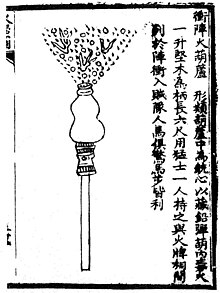
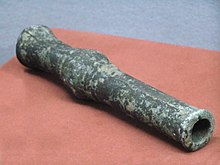
The history of the firearm begins in 10th-century China, when tubes containing gunpowder projectiles were mounted on spears to make portable fire lances. Over the following centuries, the design evolved into various types, including portable firearms such as flintlocks and blunderbusses, and fixed cannons, and by the 15th century the technology had spread through all of Eurasia. Firearms were instrumental in the fall of the Byzantine Empire and the establishment of European colonization in the Americas, Africa, and Oceania. The 19th and 20th centuries saw an acceleration in this evolution, with the introduction of the magazine, belt-fed weapons, metal cartridges, rifled barrels, and automatic firearms, including machine guns.
Older firearms typically used black powder as a propellant, but modern firearms use smokeless powder or other propellants.
There are reports of some sort of incendiary chemical weapon, the Greek fire, used by the Eastern Roman Empire (Byzantine Empire) from the 7th through the 14th centuries, which may have been delivered through grenades and/or by some kind of flamethrower. However, its nature is still being debated, and it does not seem related to ancient Chinese or modern firearms.
10th and 12th centuries

The first firearms were invented in China, following the invention of gunpowder. The earliest known depiction of a gunpowder weapon is the illustration of a fire lance on a mid-10th century silk banner from Dunhuang. The fire lance was a tube, made of paper and bamboo, filled with black-powder and attached to the end of a spear, which was used as a flamethrower. Shrapnel or pellets were sometimes placed in the barrel so that they would fly out together with the flames. The De'an Shoucheng Lu, an account of the siege of De'an in 1132 during the Jin–Song Wars, records that Song forces used fire-lances against the Jurchen.
The earliest depiction of a gun is a sculpture from a cave in Sichuan dating to the 12th century. It depicts a Chinese figure carrying a vase-shaped bombard with flames and a cannonball emerging from it.
The proportion of saltpeter in the propellant was increased to maximize its power. To better withstand that power, fire lance barrels were made of metal, At the same time, the shrapnel was replaced by projectiles whose size and shape filled the barrel more completely. The result was the hand cannon, with metal barrel, high-nitrate gunpowder, and a properly sized projectile.
13th century
The oldest surviving firearm is the Heilongjiang hand cannon dated to 1288, which was discovered in modern-day Acheng District where the History of Yuan records that battles were fought. Li Ting, a military commander of Jurchen descent, led foot soldiers armed with hand cannons to suppress the rebellion of the Eastern Christian Mongol Prince Nayan.
Kublai Khan's mostly-failed invasion of Vietnam and of Java (1258–1288) may have spread the knowledge of making gunpowder-based weapons to Southeast Asia. There is evidence of that knowledge in the Nusantara archipelago. A stele inscription by Trương Hán Siêu dated to 1312 recorded guns and shots ("súng đạn") among the loots that the Vietnamese obtained from the Chams in a campaign. It indicates that both polities had knowledge of guns and even employed them well before that date.
Ahmad Y. al-Hassan claimed that the Battle of Ain Jalut in 1260 pitted the Bahri Mamluks against the Mongol Empire. "The first cannon in history" used gunpowder almost identical with the ideal composition for explosive gunpowder. However, Iqtidar Alam Khan argued that it was the invading Mongols who introduced gunpowder to the Islamic world and cites Mamluk antagonism towards early riflemen as an example of how gunpowder weapons were not always accepted.
14th and 15th centuries
Main article: Historiography of gunpowder and gun transmission
Firearms appeared in the Middle East between the late 13th and early 14th century.
The first references to what may have been arquebuses (Ottoman Turkish: tüfek) made by the Janissary corps of the Ottoman military date them to between 1394 and 1465. However, by as late as 1444, it is unclear whether these were truly arquebuses or rather small cannons. The fact that they were listed separately from cannons in mid-15th century inventories suggests that they were handheld firearms.
The musket first appeared in the Ottoman Empire by 1465. In the Shen Qi Pu (神器譜), a firearms manual written in 1598, Chinese firearm designer and writer Zhao Shi Zhen described Turkish muskets as superior to European muskets. At some point before 1598, Turks developed a pivoting matchlock mechanism that was later modified by Zhao into the first mechanism using rack and pinion.
One major obstacle preventing matchlock guns from large-scale adoption was complaints that strong wind and rain could either blow away or ruin priming powder placed in the flash pan. Mentioned in Shen Qi Pu, Zhao later developed the "Xuanyuan arquebus" (Chinese: 軒轅銃, romanized: Xuānyuan-chòng, named for the Yellow Emperor), which used a novel rack-and-pinion mechanism. This firing mechanism was connected to both the serpentine and flash pan cover and designed so that whenever the trigger is pulled, the serpentine was lowered at the same time as flash pan cover opened, minimizing the priming powder's exposure to open air and thus reducing the risk of priming powder being blown away by strong wind or spoiled by rain. The combination of a trigger-operated flash pan cover and small copper rain cover mounted on a pendulum was considered a more sophisticated approach to the Japanese solution of covering the entire firing mechanism with a lacquered box, which could hamper aiming, shooting and reloading. The Chinese military book Wubei Zhi (1621) describes Turkish muskets that used similar rack and pinion mechanisms, which were not known to have been used in European firearms at the time.

A pole gun, the bedil tombak, was recorded in Java in 1413, The knowledge of making "true" firearms came after the middle of the 15th century. It was probably brought by Arab traders no earlier than 1460. Before the arrival of the Portuguese in Southeast Asia, primitive firearms in the form of the Java arquebus was already present.
The technology further improved after the Portuguese capture of Malacca (1511). Starting in 1513, German-Bohemian and Turkish gun-making traditions merged. This resulted in the Indo-Portuguese tradition of making matchlocks. Indian craftsmen modified the design by introducing a short, almost pistol-like buttstock held against the cheek, not the shoulder, when aiming. They reduced the caliber and made the gun lighter and more balanced. The Portuguese, who conducted much fighting aboard ships and rivercraft, valued a more compact gun, and thus this approach became popular. Malay gun founders, regarded as at the same level as those of Germany, quickly adapted these new firearms and birthed a new type of arquebus, the istinggar.
South Asia

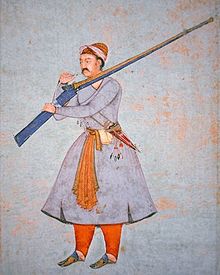
The first recorded use of firearms in South Asia was at the Battle of Adoni in 1368. In the Deccans, the Bahmani sultanate led by Mohammed Shah I used a train of artillery against the Vijayanagara Empire under Harihara II. Their use by Sultan Mohammed Shah of Gujarat in the fifteenth century was recorded. When the Portuguese reached India in 1498, they brought with them firearms, among them the matchlock musket and man-of-war (ships) armed with cannons. Portuguese travelers observed that firearms there were already in use. Peasants of the Gangetic plains used cheap handguns made by local blacksmiths. Travancore, Kashmir, Rajasthan, Punjab and Sindh hosted sites of arms manufacture. In the early 16th century, Zamorin of Calicut, had begun to emulate the Portuguese and began to arm his ships with naval gun pieces, combining local and imported technology.
In the 16th century, Central Asian prince Babur, the first Mughal emperor, brought Turkish firearms, which Mughal adversaries used against the Delhi Sultanate in the First Battle of Panipat, which the Rajputs and the Afghans in turn adopted. Across the 16th and 17th century, firearms played an important role in the Mughal military. Known as the tufang, Mughal emperor Akbar introduced many improvements in the matchlock. However until the 18th century, firearms, because of their longer loading time, were inferior to longbows. Only in the middle of the 18th century, following the French and the English, efforts were made to improve the arms and discipline of the foot soldier.
Firearms were also developed by the Marathas, although weaker than their counterparts such as the Mughals and Mysore. Balaji Baji Rao organised the arm in professional lines and Madhavji Sindhia established a more efficient gun foundry under the supervision of European gun makers. During the 18th century, Tipu Sultan was notable for effective use of guns, mortar, rockets and howitzers; the Nizam of Hyderabad manufactured guns with the help of French officers, while Sikhs under Maharaja Ranjit Singh pioneered the development of horse-artillery on the same lines as that of the East India Company.
Europe

One theory of how gunpowder came to Europe is via the Silk Road; another holds that it arrived during the Mongol invasion in the first half of the 13th century. English Privy Wardrobe accounts list ribaldis, a type of cannon, in the 1340s, and siege guns were used by the English at the Siege of Calais (1346–47).
The first mention of firearms in Russia is found in the Sofiiskii vremennik chronicle, which stated that during the 1382 defense of Moscow from Tokhtamysh's Golden Horde, Muscovites used firearms called tyufyaki (Russian: тюфяки), which were of Eastern origin; this word derives from Turkic tüfäk "gun".
Around the late 14th century in Italy, smaller, portable hand-cannons or schioppi were developed, creating in effect the first smoothbore personal firearm. The earliest surviving firearm in Europe was found in Otepää, Estonia. It dates to at least 1396.
Firearms evolved during the 1419-1434 Hussite Wars. The Hussite army consisted mostly of civilian militia who lacked the skill, experience and often weapons and armor comparable to that of the professional Crusader invaders that they faced. Gradually, Hussites pioneered battlefield use of firearms together with war wagons. Firearms were employed in auxiliary roles in 1419–1421. The first use of firearms as primary offensive weapons came in the 1421 Battle of Kutná Hora. From this moment on, firearms formed the core of Hussite tactics as well as a staple of Czech civilian possession. The Hussite militia used a number of handheld firearms, including píšťala [cs], which later found its way through German and French into English as the term pistol, hákovnice [cs], an infantry weapon heavier than píšťala, and yet heavier tarasnic (fauconneau). For artillery, Hussites used the Czech: houfnice, which gave rise to the English term, "howitzer" (houf meaning crowd for its intended use of shooting stone and iron shot against massed enemy forces), bombarda (mortar) and dělo (cannon). The first English source about handheld firearms discussed hand cannons in 1473. In the late 15th century, the Ottoman Empire used firearms as part of its regular infantry. The earliest type of Turkish hand cannons are called Şakaloz, after the Hungarian hand cannon Szakállas puska in the 15th century.
Early modern age
This section has multiple issues. Please help improve it or discuss these issues on the talk page. (Learn how and when to remove these messages)
|
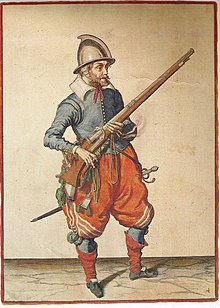
During the early modern age, hand-held cannons evolved into the matchlock, wheellock, doglock, and flintlock rifle, respectively, as ignition devices, matchlocks, wheellocks, snaplock, flintlocks and percussion caps were used in turn. This was then followed by the breech loader and finally the automatic weapon. The paper cartridge was introduced sometime before 1586, and the bayonet came to use in 16th century France. Hand grenades, thrown by grenadiers, appeared around the same time.
Early cartridge firearms had to be cocked and caught by the "sear", which holds the hammer back, before each shot. Pulling the trigger allows the hammer or striker to fly forward, striking the "firing pin," which then strikes the "primer," igniting an impact-sensitive chemical compound (historically, first fulminate of mercury, then potassium chlorate, now lead styphnate) which shoots a flame through the "flash hole" into the cartridge's propellant chamber, igniting the propellant.
The Springfield Armory in Springfield, Massachusetts became important during the 1850s, when it debuted the Springfield rifle. Springfield rifles were among the first breech-loading rifles, starting production in 1865. By that time, metallurgy had developed sufficiently so that brass could be made into ammunition cases. Previously, each round was custom-made as needed: the shooter poured loose powder down the barrel, used leather or cloth for wadding if time allowed, selected a suitable projectile (lead ball, rocks, arrow, or nails), then seated the projectile on top of the powder charge by means of a ramrod. Performance was erratic. Fixed ammunition combined a primer, the pre-measured charge, and the projectile in a water-resistant brass cartridge case. Most importantly, the soft brass expanded under pressure of the gas to seal the rear end of the barrel, which prevented the shooter from being maimed by escaping high-pressure gas when they pulled the trigger.
Repeating and automatic firearms

A repeating firearm, ("repeater") can hold multiple cartridges and be fired multiple times before reloading. Repeaters employ a variety of mechanisms for readying a bullet for firing. This typically involves ejecting a used cartridge and moving a new one into the firing chamber. Mechanisms include bolt-action, lever-action, slide-action, semi-automatic, and fully-automatic firearms. Automatic weapons cycle a new round into the firing chamber without the help of the shooter. Semi-automatics fire one round per trigger pull. Full automatics fire multiple rounds per pull.
Revolvers
Revolvers hold cartridges in a rotating cylinder, which serves as both a magazine and firing chamber. They were the earliest repeaters. Revolving rifles were sometimes called "turret guns". Single action revolvers were fired after manually cocking the hammer for each shot. This design dates from at least 1836, with the introduction of the Colt Paterson. Double-action revolvers emerged around the same time. They can be fired after cocking the hammer, but also by pulling the trigger without first cocking it. Double-action only or DAO revolvers can be fired only using the trigger.
The Springfield Model 1892–99 was used during the Spanish–American War.
Self-loaders
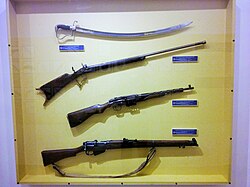
The first successful self-loader was the Gatling gun, a hand-cranked revolver. It was invented by Richard Jordan Gatling and fielded by the Union forces during the American Civil War. Self-loaders use energy to reload. The world's first machine gun was the Maxim gun, developed by British inventor Sir Hiram Maxim in 1884.
The world's first successful self-loading rifle was the Mondragón rifle, designed in 1908 by Mexican general Manuel Mondragón. It was the first self-loading firearm able to be operated by one person. It was used during the Mexican Revolution (Mexican Army) and World War I (Imperial German Flying Corps).
The first submachine gun, which fires pistol cartridges and can be used by one soldier, was the MP18.1, invented by Theodor Bergmann. It was introduced in 1918 by the German Army as the primary weapon of the Stosstruppen (assault groups specialized in trench combat). During World War II well-crafted versions such as the Thompson were replaced by mass-produced alternatives, such as the M3.
The first successful assault rifle was the StG 44, introduced during World War II by the Germans. It was the first firearm to occupy the gap between rifles and submachine guns. The assault rifle was more powerful and had longer range than the submachine gun, but was less powerful and shorter range than standard rifles. It used intermediate size rounds as well and offered select-fire option (switch from full automatic to semi-automatic). The AK-47, commonly known as the "Kalashnikov", is the most manufactured assault rifle.
The battle rifle was a select-fire rifle that retained the long range of the M1 Garand. NATO members adopted battle rifles of their own. In practice, the powerful cartridge of the battle rifle proved to be difficult to control during fully automatic fire.
See also
- Science and technology of the Song dynasty
- Jiao Yu
- Huolongjing
- History of cannon
- History of weapons
- Military history
- Table of handgun and rifle cartridges
- Gunpowder artillery in the Song dynasty
References
- Helaine Selin (1997). Encyclopaedia of the History of Science, Technology, and Medicine in Non-Western Cultures. Springer. p. 389. ISBN 978-0-7923-4066-9. Archived from the original on 9 October 2013. Retrieved 30 July 2013.
- Needham 1986, pp. 8–9
- ^ Chase 2003, pp. 31–32
- ^ Crosby 2002, p. 99
- Needham 1986:222
- Gwei-Djen, Lu; Needham, Joseph; Chi-Hsing, Phan (July 1988). "The Oldest Representation of a Bombard". Technology and Culture. 29 (3): 594–605. doi:10.2307/3105275. JSTOR 3105275. S2CID 112733319.
- Chase 2003:31–32
- Needham 1986, p. 10
- Andrade 2016, p. 52.
- Needham 1986:293–294
- Đông Nguyễn, Kaovjets Ngujens (2023). Lôi Động, Tinh Phi. NXB Dân Trí. p. 75.
- Hassan, Ahmad Y. "Gunpowder Composition for Rockets and Cannon in Arabic Military Treatises In Thirteenth and Fourteenth Centuries". www.history-science-technology.com. History of Science and Technology in Islam. Archived from the original on 2008-02-26. Retrieved 2023-01-31.
- Hassan, Ahmad Y. "Technology Transfer in the Chemical Industries". www.history-science-technology.com. History of Science and Technology in Islam. Archived from the original on 2007-04-27.
- Khan, Iqtidar Alam (1996), "Coming of Gunpowder to the Islamic World and North India: Spotlight on the Role of the Mongols", Journal of Asian History, 30: 41–5.
- Khan, Iqtidar Alam (2004), Gunpowder and Firearms: Warfare in Medieval India, Oxford University Press.
- Al-Hassan, Ahmad Y. (2003). "Gunpowder Composition for Rockets and Cannon in Arabic Military Treatises in the Thirteenth and Fourteenth Centuries". ICON. 9. International Committee for the History of Technology: 1–30. ISSN 1361-8113. JSTOR 23790667.
- Broughton, George; Burris, David (2010). "War and Medicine: A Brief History of the Military's Contribution to Wound Care Through World War I". Advances in Wound Care: Volume 1. Mary Ann Liebert. pp. 3–7. doi:10.1089/9781934854013.3 (inactive 1 November 2024). ISBN 9781934854013. Archived from the original on 3 April 2019. Retrieved 24 April 2019.
The first-hand cannon appeared during the 1260 Battle of Ain Jalut between the Egyptians and Mongols in the Middle East.
{{cite book}}: CS1 maint: DOI inactive as of November 2024 (link) - Books, Amber; Dickie, Iain; Jestice, Phyllis; Jorgensen, Christer; Rice, Rob S.; Dougherty, Martin J. (2009). Fighting Techniques of Naval Warfare: Strategy, Weapons, Commanders, and Ships: 1190 BC – Present. St. Martin's Press. p. 63. ISBN 9780312554538.
Known to the Arabs as midfa, was the ancestor of all subsequent forms of cannon. Materials evolved from bamboo to wood to iron quickly enough for the Egyptian Mamelukes to employ the weapon against the Mongols at the battle of Ain Jalut in 1260, which ended the Mongol advance into the Mediterranean world.
- Chase 2003:1 "The Europeans certainly had firearms by the first half of the 14th century. The Arabs obtained firearms in the 14th century too, and the Turks, Iranians, and Indians all got them no later than the 15th century, in each case directly or indirectly from the Europeans. The Koreans adopted firearms from the Chinese in the 14th century, but the Japanese did not acquire them until the 16th century, and then from the Portuguese rather than the Chinese."
- Needham 1986, p. 443.
- Ágoston, Gábor (2011). "Military Transformation in the Ottoman Empire and Russia, 1500–1800". Kritika: Explorations in Russian and Eurasian History. 12 (2): 281–319 . doi:10.1353/kri.2011.0018. S2CID 19755686.
Initially the Janissaries were equipped with bows, crossbows, and javelins. In the first half of the 15th century, they began to use matchlock arquebuses
- Ayalon, David (2013). Gunpowder and Firearms in the Mamluk Kingdom: A Challenge to Medieval Society (1956). Routledge. p. 126. ISBN 9781136277320. Archived from the original on 2023-01-31. Retrieved 2023-01-31.
- Needham 1986, p. 444.
- Needham 1986, p. 446.
- Mayers (1876). "Chinese explorations of the Indian Ocean during the fifteenth century". The China Review. IV: p. 178.
- Manguin, Pierre-Yves (1976). "L'Artillerie legere nousantarienne: A propos de six canons conserves dans des collections portugaises" (PDF). Arts Asiatiques. 32: 233–268. doi:10.3406/arasi.1976.1103. S2CID 191565174. Archived (PDF) from the original on 2020-10-17. Retrieved 2020-09-09.
- Crawfurd, John (1856). A Descriptive Dictionary of the Indian Islands and Adjacent Countries. Bradbury and Evans.
- Tiaoyuan, Li (1969). South Vietnamese Notes. Guangju Book Office.
- Andaya, L. Y. 1999. Interaction with the outside world and adaptation in Southeast Asian society 1500–1800. In The Cambridge history of southeast Asia. ed. Nicholas Tarling. Cambridge: Cambridge University Press, p. 345–401.
- The bewitched gun : the introduction of the firearm in the Far East by the Portuguese, by Rainer Daehnhardt 1994.
- Eaton, Richard M. (2013). Expanding Frontiers in South Asian and World History: Essays in Honour of John F. Richards. Cambridge: Cambridge University Press. ISBN 9781107034280.
- Egerton, W. (1880). An Illustrated Handbook of Indian Arms. W.H. Allen.
- Tarling, Nicholas (1992). The Cambridge History of Southeast Asia: Volume 1, From Early Times to C.1800. Cambridge University Press. ISBN 9780521355056.
- "The Official Home Page of the Indian Army". www.indianarmy.nic.in. Archived from the original on 2017-06-26. Retrieved 2022-12-27.
- ^ Singh, Jagjit (2006). Artillery: The Battle-Winning Arm. Lancer Publishers, New Delhi. ISBN 978-8176021807.
- Eaton, Richard M.; Wagoner, Philip B. (2014-03-01). "Warfare on the Deccan Plateau, 1450-1600: a military revolution in early modern India?". Journal of World History. 25 (1): 5–52. doi:10.1353/jwh.2014.0004. S2CID 162260578.
- ^ "Guns and the British Empire | Center for South Asia". southasia.stanford.edu. Archived from the original on 2022-12-27. Retrieved 2022-12-27.
- ^ "Anjan Mukherjee in Evolution of Indian Artillery and its Impact on India's Comprehensive Military Power, chapter II" (PDF). Retrieved 2021-05-26.
- Richards 1993, p. 288.
- Norris 2003:11
- Chase 2003:58
- David Nicolle, Crécy 1346: Triumph of the longbow, Osprey Publishing; June 25, 2000; ISBN 978-1-85532-966-9.
- "Firearms in Russia". Archived from the original on 2010-07-06. Retrieved 2007-04-24.
- "Первые залпы. РУССКАЯ КНИГА РЕКОРДОВ И ДОСТИЖЕНИЙ". bibliotekar.ru. Archived from the original on 2007-03-09. Retrieved 2007-04-24.
- "Ain Mäesalu: Otepää püss on maailma vanim". Archived from the original on 2012-06-14. Retrieved 2010-06-30.
- Titz, Karel (1922). Ohlasy husitského válečnictví v Evropě. Československý vědecký ústav vojenský.
- Harper, Douglas. "howitzer". Online Etymology Dictionary. Archived from the original on 2 December 2013. Retrieved 18 January 2014.
- The Concise Oxford English Dictionary (4 ed.). 1956. pp. Howitzer.
- Hermann, Paul (1960). Deutsches Wörterbuch (in German). pp. Haubitze.
- Gawron, Tomáš (January 2021). "Unikátní české výročí: 600 let civilního držení palných zbraní [Unique Czech anniversary: 600 years of civilian firearms possession]". zbrojnice.com (in Czech). Archived from the original on 13 January 2021. Retrieved 1 January 2021.
- W.W. Greener (2013). The Gun and Its Development. Simon and Schuster. p. 78. ISBN 9781510720251.
- Brett D. Steele (2005). The Heirs of Archimedes: Science and the Art of War Through the Age of Enlightenment. MIT Press. p. 120. ISBN 9780262195164. Archived from the original on 2022-11-10. Retrieved 2022-11-10.
- "Firsts | Springfield 375". Archived from the original on 2013-05-21. Retrieved 2012-04-04.
- Walker, Robert E. (2013). Cartridges and Firearm Identification. USA: CRC Press. p. 285. ISBN 978-1-4665-0206-2.
Bibliography
- Andrade, Tonio (2016). The Gunpowder Age: China, Military Innovation, and the Rise of the West in World History. Princeton University Press. ISBN 978-0-691-13597-7.
- Buchanan, Brenda J. (2006), Gunpowder, Explosives and the State: A Technological History, Aldershot: Ashgate, ISBN 978-0-7546-5259-5
- Chase, Kenneth (2003), Firearms: A Global History to 1700, Cambridge University Press, ISBN 978-0-521-82274-9
- Crosby, Alfred W. (2002), Throwing Fire: Projectile Technology Through History, Cambridge University Press, ISBN 978-0-521-79158-8
- Kelly, Jack (2004), Gunpowder: Alchemy, Bombards & Pyrotechnics: The History of the Explosive that Changed the World, Basic Books, ISBN 978-0-465-03718-6
- Needham, Joseph (1986), Science & Civilisation in China, vol. V:7: The Gunpowder Epic, Cambridge University Press, ISBN 978-0-521-30358-3
- Norris, John (2003), Early Gunpowder Artillery: 1300-1600, Marlborough: The Crowood Press.
- Richards, John F. (1993). The Mughal Empire. Cambridge University Press. p. 288. ISBN 978-0-521-56603-2.
- Sun Laichen (2006) Chinese Gunpowder Technology Technology and Dai Viet, ca. 1390 -1497. In Vietnam Borderless Histories Eds Nhung Tuyet Tran & Anthony Reid University of Wisconsin Press
Further reading
- Chase, Kenneth. Firearms: A Global History to 1700 (2008) excerpt
- DK. Firearms: An Illustrated History (2014) excerpt
- Pyhrr, Stuart W. (1985). Firearms from the collections of the Prince of Liechtenstein. New York: The Metropolitan Museum of Art. ISBN 9780870994258.
- Silverman, David J. Thundersticks: Firearms and the Violent Transformation of Native America (2016) excerpt
- Wills, Chuck and Robert Lindley. The Illustrated History of Guns: From First Firearms to Semiautomatic Weapons (2014) excerpt